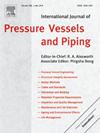Study on the hydrogen diffusion behavior in pipeline girth welds based on segmented moving double ellipsoid heat source model
IF 3
2区 工程技术
Q2 ENGINEERING, MECHANICAL
International Journal of Pressure Vessels and Piping
Pub Date : 2025-05-13
DOI:10.1016/j.ijpvp.2025.105556
引用次数: 0
Abstract
This study addresses the increased risk of hydrogen-induced failure caused by localized hydrogen enrichment in the hydrogen-blended pipeline girth welds. A hydrogen diffusion model for the hydrogen-infused pipeline girth weld is established based on the segmented moving double ellipsoid heat source boundary condition. Based on full-scale pipeline welding experiments, a three-dimensional six-layer six-pass model for X80 pipeline girth welds is established using ABAQUS and subroutine technology, considering the segmented moving double ellipsoid heat source boundary condition. Based on model and experimental verification, the temperature and residual stress fields during the welding process are analyzed. Hydrogen diffusion simulations are conducted using diffusion parameters from different regions and weld passes of the pipeline girth weld to investigate the influence of residual stress on the hydrogen diffusion behavior in the weld. The results indicate that the temperature field and residual stress field calculated using the segmented double ellipsoid heat source model show good agreement with experimental data, with computational times being 1/3 of those for the double ellipsoid heat source model, respectively. Regarding the hydrogen diffusion coefficient, the diffusion coefficients in the heat-affected zone and weld metal increased to varying degrees compared to the base metal due to the influence of grain structure and dislocation density. Moreover, welding residual stress promotes the diffusion and accumulation of hydrogen, with the maximum hydrogen concentration in the weld centre region increasing by 3.3 times compared to when residual stress is not considered, while the steady-state time is reduced to 5.2E5 seconds.
基于分段运动双椭球热源模型的管道环焊缝氢气扩散行为研究
该研究解决了氢混合管道环焊缝中局部富氢引起的氢诱发失效风险增加的问题。基于分段运动双椭球热源边界条件,建立了输氢管道环焊缝氢气扩散模型。在全尺寸管道焊接实验的基础上,考虑分段移动双椭球热源边界条件,利用ABAQUS和子程序技术建立了X80管道环焊缝的三维六层六道次模型。基于模型和实验验证,分析了焊接过程中的温度场和残余应力场。采用管道环焊缝不同区域和不同焊道的扩散参数进行氢扩散模拟,研究残余应力对焊缝中氢扩散行为的影响。结果表明:采用分段双椭球热源模型计算的温度场和残余应力场与实验数据吻合较好,计算次数分别为双椭球热源模型的1/3;在氢扩散系数方面,由于晶粒组织和位错密度的影响,热影响区和焊缝金属中的氢扩散系数相对于母材均有不同程度的增大。焊接残余应力促进了氢气的扩散和积累,焊缝中心区域最大氢气浓度比不考虑残余应力时增加了3.3倍,而稳态时间缩短到5.2E5秒。
本文章由计算机程序翻译,如有差异,请以英文原文为准。
求助全文
约1分钟内获得全文
求助全文
来源期刊
CiteScore
5.30
自引率
13.30%
发文量
208
审稿时长
17 months
期刊介绍:
Pressure vessel engineering technology is of importance in many branches of industry. This journal publishes the latest research results and related information on all its associated aspects, with particular emphasis on the structural integrity assessment, maintenance and life extension of pressurised process engineering plants.
The anticipated coverage of the International Journal of Pressure Vessels and Piping ranges from simple mass-produced pressure vessels to large custom-built vessels and tanks. Pressure vessels technology is a developing field, and contributions on the following topics will therefore be welcome:
• Pressure vessel engineering
• Structural integrity assessment
• Design methods
• Codes and standards
• Fabrication and welding
• Materials properties requirements
• Inspection and quality management
• Maintenance and life extension
• Ageing and environmental effects
• Life management
Of particular importance are papers covering aspects of significant practical application which could lead to major improvements in economy, reliability and useful life. While most accepted papers represent the results of original applied research, critical reviews of topical interest by world-leading experts will also appear from time to time.
International Journal of Pressure Vessels and Piping is indispensable reading for engineering professionals involved in the energy, petrochemicals, process plant, transport, aerospace and related industries; for manufacturers of pressure vessels and ancillary equipment; and for academics pursuing research in these areas.

 求助内容:
求助内容: 应助结果提醒方式:
应助结果提醒方式:


